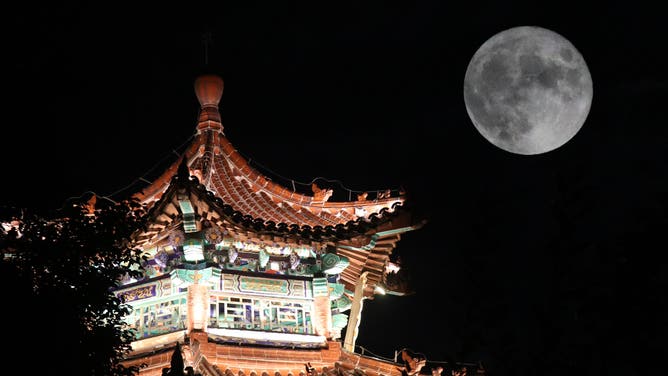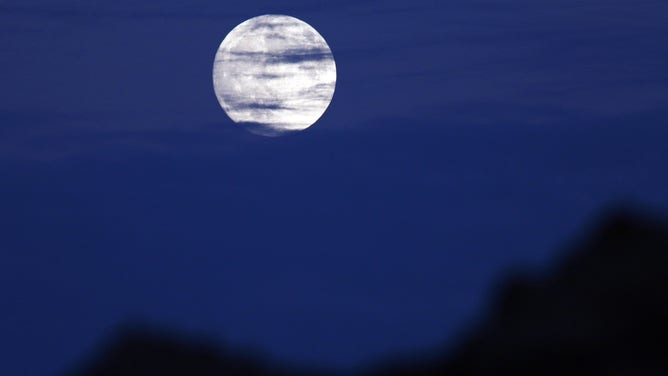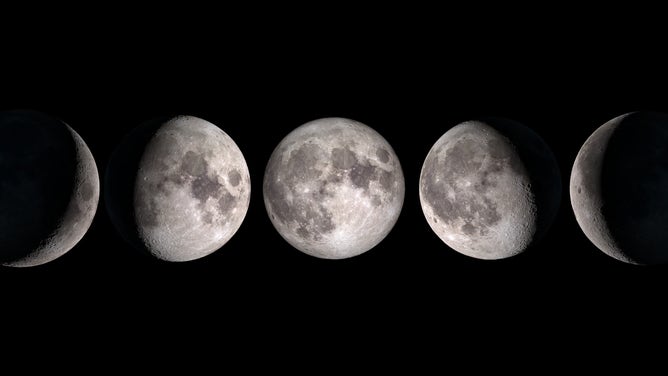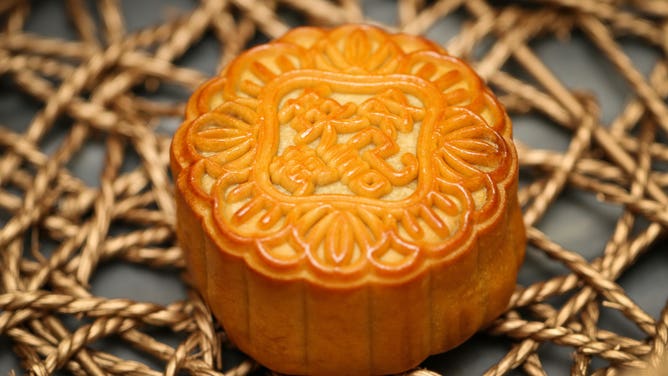How an autumn festival was inspired by a love story
On Sept. 10, over a billion people around the world will celebrate Mid-Autumn Festival, a “Thanksgiving” for many East and Southeast Asian families.

With the full moon up above, a performer dances in front of a man-made moon during Mid-Autumn Festival in Zaozhuang, Shandong Province of China.
(Gao Qiming/VCG / Getty Images)
He was a hero, and she held immortality in her hands...
So goes the most popular legend behind one of Asia's largest holidays, Mid-Autumn Festival. It's a time when many East and Southeast Asian families reunite at home, share meals and partake in various traditions.
"Thousands of years of history have written about this tradition, and it’s one of the major traditions we host each year," said Wellington Z. Chen, the Executive Director of the Chinatown Business Improvement District and the Chinatown Partnership in New York City.
"Sometimes it’s called Moon Festival," said David Uy, Executive Director of the Chinese American Museum in Washington, DC. "Like a lot of holidays, it's a time to bring family together and celebrate — an appreciation of harvest, prosperity and fortune."
As its name implies, the Moon Festival revolves around our moon and the many myths and traditions it helped spawn.
One of them was a story about two star-crossed lovers, Hou Yi and his wife Chang'e, whose tragic fate would be memorialized in the festival.
Hou Yi and Chang’e

The moon rises over a tower during Mid-Autumn Festival on September 21, 2021 in Tai'an, Shandong Province of China.
(VCG / Getty Images)
The legendary tale began long ago.
The planet looked different, with the gods reigning supreme and the sky burning with the fury of ten suns. The many suns scorched the Earth's surface, bringing drought to the land, destroying crop yields and causing death and poverty. One of the gods asked Hou Yi, an archer, to save the planet by shooting down some of the suns. Hou Yi shot nine out of the sky, leaving the one sun we know today.
This heroic feat brought Hou Yi into the good graces of the gods. In fact, the goddess of heaven gifted Hou Yi an elixir that would make him immortal and allow him to join the gods, should he choose to drink it. But by relinquishing his mortality, Hou Yi would also have to leave his beloved wife, Chang’e. So rather than drink the elixir, he gave it to Chang’e to treasure and keep safe.
Word spread about the elixir of immortality, and it attracted some evil attention. On one fateful day, when Chang’e was alone at home, a man wielding a sword came by and tried to force her to hand him the elixir. To prevent the elixir from falling into the wrong hands, Chang’e decided to drink it. At that moment, her body began to float and ascend high into the heavens until she landed on the moon.

The full moon is seen during the Mid-Autumn Festival in 2015 in Zaozhuang, Shandong Province of China.
(Visual China Group / Getty Images)
Hou Yi was devastated when he learned about what happened to Chang’e. While becoming immortal saved her from an evil man, it ended her life with her beloved husband, who was left alone and heartbroken.
In an attempt to see his wife once again, Hou Yi began an annual tradition when the moon was at its brightest. He’d prepare a table with incense and his wife’s favorite foods, in hopes that she would see them from her perch on the moon and one day return home.
"Could you imagine if you love somebody and you only get to meet once a year?" said Chen. "This is the significance of the moon and the romanticism associated with it."
Today, this love story is one of many that help explain the mythical origins of Mid-Autumn Festival. There are also many different versions of each story, but the common theme in all of them is the focus on the moon.
How the Festival focuses on the moon

According to NASA, the moon’s complexion cycles between being completely dark and fully lit every 29.5 days. Names like new moon, full moon, waxing crescent and waning gibbous describe its appearance at each stage of this cycle.
(NASA)
Mid-Autumn Festival began thousands of years ago, when it was timed with the lunar calendar. The lunar calendar far predates the Gregorian calendar typically used today, and it’s based on the cycles of the phases of the moon.
In ancient times, the calendar was instrumental, especially in timing the harvest season. Mid-Autumn Festival, which originally cued the autumn harvest for many, is timed with the biggest and brightest moon of the year.
LEARN ABOUT ANOTHER FESTIVAL TIMED WITH THE AUTUMN HARVEST
In 2022, the moon will be at its peak on Sept. 10. Over a billion people will come together to celebrate this age-old tradition of honoring the moon and what it meant to countless generations.
Contemporary celebrations around the world

Zhang Xu shows a freshly-baked mooncake at the mooncake bakery Jingshengchang in Xiayi County, Shangqiu, central China's Henan Province.
(Feng Dapeng/Xinhua / Getty Images)
While the holiday has evolved and the autumn harvest has taken a backseat to contemporary forms of celebration, the moon is still the focal point for the festivities. Some customs include hosting moon-viewing parties and enjoying round pastries called "moon cakes".
"It’s a dessert cake," said Uy. "They’re usually the size of the palm of your hand or smaller, and they all come in different varieties. They’re usually made out of white lotus seed and inside — this might seem odd to some — is a salted duck egg. So, getting that sweet and salty mix might seem unusual, but it really is quite delicious."
Uy also said the mooncakes are formed in a mold so that they have really intricate shapes and patterns on them.
"The circle is meaningful"

Mooncakes are often made out of white lotus seed and contain a salted duck egg inside.
(Renato Marques)
The circular form of the mooncake — and its lunar namesake — goes far beyond the outline of the pastry.
"The circle is meaningful because the belief is family and harmony," said Chen. "Just like King Arthur’s table, where everyone is equal, everyone is included because the circle is very inclusive."
This inclusivity and focus on family form the bedrock of the Mid-Autumn Festival.
"As Chinese Americans, we look forward to it because it's peaceful, it's serene. Because the moon is not like the sun — it's not harsh or beating you down with the heat. It's very gentle and soothing," said Chen.
"[The Festival] is about sipping tea together and chatting and sharing stories. It really is communal and harmonious."